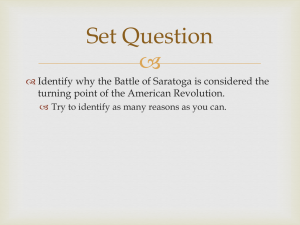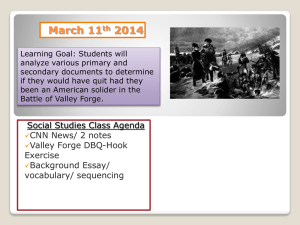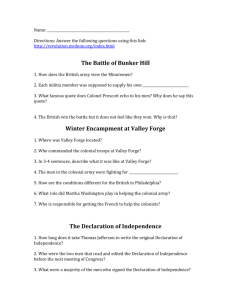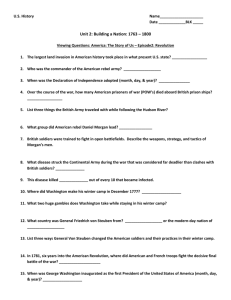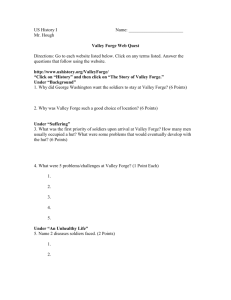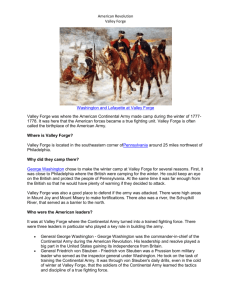The Story of Valley Forge - MissDWorldofSocialStudies
advertisement
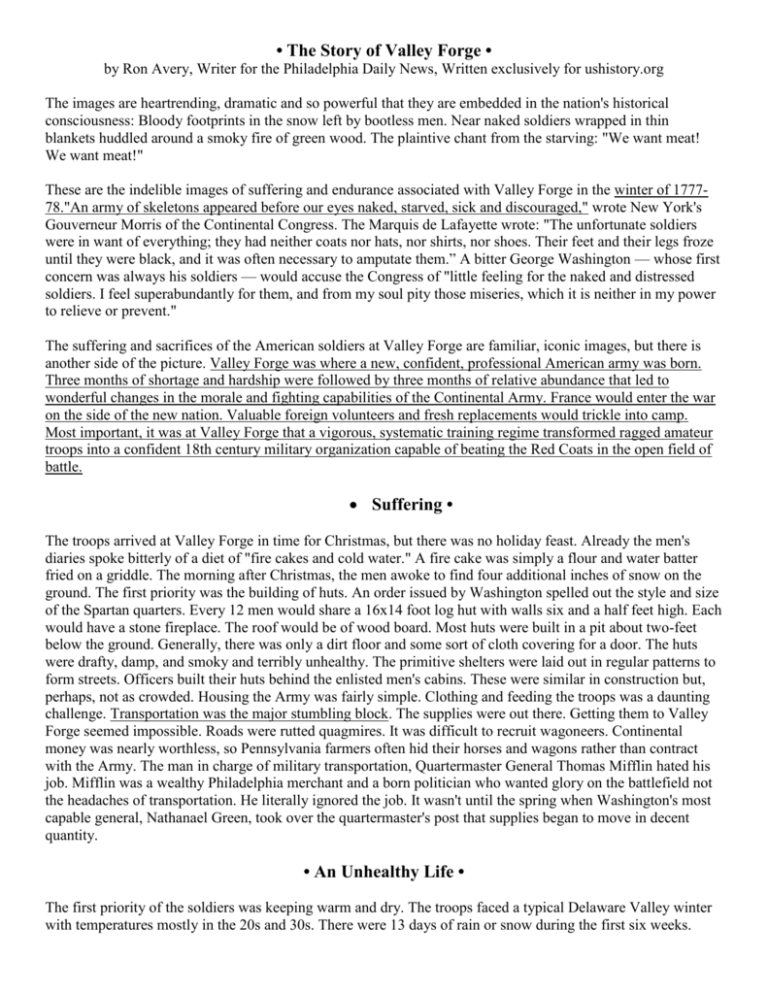
• The Story of Valley Forge • by Ron Avery, Writer for the Philadelphia Daily News, Written exclusively for ushistory.org The images are heartrending, dramatic and so powerful that they are embedded in the nation's historical consciousness: Bloody footprints in the snow left by bootless men. Near naked soldiers wrapped in thin blankets huddled around a smoky fire of green wood. The plaintive chant from the starving: "We want meat! We want meat!" These are the indelible images of suffering and endurance associated with Valley Forge in the winter of 177778."An army of skeletons appeared before our eyes naked, starved, sick and discouraged," wrote New York's Gouverneur Morris of the Continental Congress. The Marquis de Lafayette wrote: "The unfortunate soldiers were in want of everything; they had neither coats nor hats, nor shirts, nor shoes. Their feet and their legs froze until they were black, and it was often necessary to amputate them.” A bitter George Washington — whose first concern was always his soldiers — would accuse the Congress of "little feeling for the naked and distressed soldiers. I feel superabundantly for them, and from my soul pity those miseries, which it is neither in my power to relieve or prevent." The suffering and sacrifices of the American soldiers at Valley Forge are familiar, iconic images, but there is another side of the picture. Valley Forge was where a new, confident, professional American army was born. Three months of shortage and hardship were followed by three months of relative abundance that led to wonderful changes in the morale and fighting capabilities of the Continental Army. France would enter the war on the side of the new nation. Valuable foreign volunteers and fresh replacements would trickle into camp. Most important, it was at Valley Forge that a vigorous, systematic training regime transformed ragged amateur troops into a confident 18th century military organization capable of beating the Red Coats in the open field of battle. Suffering • The troops arrived at Valley Forge in time for Christmas, but there was no holiday feast. Already the men's diaries spoke bitterly of a diet of "fire cakes and cold water." A fire cake was simply a flour and water batter fried on a griddle. The morning after Christmas, the men awoke to find four additional inches of snow on the ground. The first priority was the building of huts. An order issued by Washington spelled out the style and size of the Spartan quarters. Every 12 men would share a 16x14 foot log hut with walls six and a half feet high. Each would have a stone fireplace. The roof would be of wood board. Most huts were built in a pit about two-feet below the ground. Generally, there was only a dirt floor and some sort of cloth covering for a door. The huts were drafty, damp, and smoky and terribly unhealthy. The primitive shelters were laid out in regular patterns to form streets. Officers built their huts behind the enlisted men's cabins. These were similar in construction but, perhaps, not as crowded. Housing the Army was fairly simple. Clothing and feeding the troops was a daunting challenge. Transportation was the major stumbling block. The supplies were out there. Getting them to Valley Forge seemed impossible. Roads were rutted quagmires. It was difficult to recruit wagoneers. Continental money was nearly worthless, so Pennsylvania farmers often hid their horses and wagons rather than contract with the Army. The man in charge of military transportation, Quartermaster General Thomas Mifflin hated his job. Mifflin was a wealthy Philadelphia merchant and a born politician who wanted glory on the battlefield not the headaches of transportation. He literally ignored the job. It wasn't until the spring when Washington's most capable general, Nathanael Green, took over the quartermaster's post that supplies began to move in decent quantity. • An Unhealthy Life • The first priority of the soldiers was keeping warm and dry. The troops faced a typical Delaware Valley winter with temperatures mostly in the 20s and 30s. There were 13 days of rain or snow during the first six weeks. Illness, not musket balls, was the great killer. Dysentery and typhus were rampant. Many makeshift hospitals were set up in the region. The Army's medical department used at least 50 barns, dwellings, churches or meetinghouses throughout a wide area of Eastern Pennsylvania as temporary hospitals. These places were mostly understaffed, fetid breeding grounds of disease. All were chronically short of medical supplies. America's first true military hospital — constructed for that purpose — was built at Yellow Springs, a popular health spa about 10 miles west of the encampment. About 300 sick men were accommodated in the large threestory wood structure. Washington once visited the Yellow Springs Hospital and stopped to exchange a few words with each patient. Dr. Bodo Otto, an elderly German and his two physician sons, ably ran the hospital until the end of the war. Much of the sickness was traceable to unhealthy sanitation and poor personal hygiene. Washington constantly complained of the failure to clear the encampment of filth, which included rotting carcasses of horses. The commander-in-chief even issued orders concerning the use and care of privies, but men relieved themselves wherever they felt.” Intolerable smells" finally prompted Washington to issue orders that soldiers who relieved themselves anywhere but in "a proper Necessary" were to receive five lashes. In the absence of wells, water was drawn from the Schuylkill River and nearby creeks. Men and animals often relieved themselves upstream from where water for drinking was drawn. One of Washington's major worries was an outbreak of small pox. Inoculation was still relatively new and controversial, but the General was a firm believer in the procedure. The winter before at Morristown, N.J., he ordered inoculation for all those who had not already had the disease. A survey at Valley Forge showed many vulnerable soldiers. Some 3,000 to 4,000 men were vaccinated. Knowing how unhealthy the congested the huts were, Washington ordered windows cut for circulation in the spring and even encouraged some to move from their squalid quarters into tents. Just how many became seriously ill during the Valley Forge encampment and how many died of these illnesses is not known. Even in the mild weather of late spring, the medical department informed Washington that 1,000 men were too ill for combat. Those who died at camp or in hospitals has been estimated as high as 3,000. • Things Improve • In early March, the energetic and competent Gen. Nathanael Greene was appointed quartermaster general, and soon things improve rapidly. Greene got down to business by dispatching engineers to improve bridges and roads between Valley Forge and Lancaster. Wagons began arriving with clothing and food. Also in early March a baking company of some 70 men headed by Philadelphia gingerbread baker Christopher Ludwig arrived at camp. The German-born patriot refused to profit from his labor. Eventually, each soldier got the daily pound of bread promised by Congress. Ludwig, himself, baked for the headquarters staff and often spoke with Washington. In April great schools of shad surged up the Schuylkill River to spawn. Thousands were netted, and the soldiers gorged themselves. Hundreds of barrels were filled with salted shad for future use. One soldier wrote, "For almost a month the whole camp stank and men's fingers were oily.” Despite Washington's daily orders, there was little real military discipline in the camp. General John Sullivan once commented, "This is not an Army; it's a mob.” There were no regular roll calls. Sizes of units that were supposed to be equal varied radically. Orders prohibiting gambling, fighting, selling Army equipment and wandering away from camp were routinely ignored. While brave, Continental troops possessed few skills in the art of 18th century warfare. They didn't know how to march in ranks or maneuver on the battlefield. The bayonet — crucial to battlefield success — was used mostly to cook over a fire. All this was about to change with the arrival in late February of Friedrich Wilhelm Ludolf Gerhard Augustin Stuebe, known to history as Baron von Steuben. The title was of his own making. He had served in the Prussian Army of Frederick the Great but rose no higher than captain. Now, at age 47, he was out of work and applying for military posts in several places. In Paris, Steuben impressed American envoys, Benjamin Franklin and Silas Deane, who provided the German with a glowing letter of recommendation. Some suggest that Franklin inflated Steuben's military credentials and coached him on how best to get an appointment. Like the Marquis de Lafayette, the Baron said the right words when he spoke to members of the Congress and the Board of War: He would serve without a salary. He did, however, want his expenses paid. Both the War Board and Washington liked the man's modesty and viewed Steuben as a possible candidate for inspector general of the Army. Steuben was appalled by what he observed during his first weeks at Valley Forge. Washington asked the German to study the situation and provide reports on camp defenses, troop morale and military readiness. Steuben's reports were detailed and astute. In a short time, Steuben was named acting inspector general. His primary mission involved training, and he attacked the task with dedication and zeal. Washington liked Steuben immediately even though the Prussian could not speak English. But he could speak French, and Washington appointed two of his French-speaking aides, Alexander Hamilton and John Laurens to work with the Prussian. Steuben has been called history's only popular drillmaster. The men loved his gruff manner, his cursing in broken English and his hands-on-style of demonstrating every move personally. He insisted that officers drill with their men, and he pared down the officers' staffs of personal servants. He created his own manual of arms and drill to fit the American situation. Simplicity was the keynote. The training started with a select group of 100. When these men knew what they were doing, he released them to teach others. Soon he was drilling large masses of entire regiments and brigades. He constantly taught the use of the bayonet. He gave lessons in mounting guard and sentry duty. He insisted that every watch be synchronized with the headquarters' clock. And page-by-page Steuben wrote in French an army drill book that was then translated into English. "Regulation for the Order of Discipline of the Troops of the United States" was then copied by an officer in each brigade. Within weeks, everyone could see a new proficiency and new pride among the formerly dispirited men. There were other factors coming together to boost morale and send sagging spirits soaring. Most important, France entered the war as an ally of the new nation. America got the good news in April. Great festivities were held in camp on May 5. Along with prayer, parading and gun salutes, each man was issued a gill of rum. French-made uniforms and military gear soon began arriving in camp. Back in March, an extra month's pay was issued to all in camp for having stuck it out through the miseries of the winter. Washington added a ration of rum for each soldier. Farmers began bringing their produce to a camp market and fresh military units arrived at Valley Forge. • Leaving Valley Forge • Philadelphia was a difficult place for the British to defend. Now that France was in the war, the city was also vulnerable to attack or blockade from the sea. It was decided to abandon the Quaker City and move British forces back to their base in New York City. The British completed their evacuation on June 18th. An estimated 3,000 Tories left the city with the troops. Within hours, American cavalry arrived in the city. Ready to move against the retreating British, Washington abandoned Valley Forge on June 9 by crossing the Schuylkill River and setting up camp a mile away. He ordered work parties to clean up the old campgrounds, filling the latrines and burying all garbage. The general was waiting for the British to make their move north through New Jersey. And when word came that the Red Coats were gone on June 18th, he followed immediately. Now the Continental Army was ready to fight. Professionalism, confidence and pride marked those who had survived the ordeal of Valley Forge. The two armies clashed on June 28 at Monmouth Courthouse. The battle was almost single-handedly lost by an inept but always arrogant Gen. Charles Lee. When Washington learned that Lee was retreating instead of advancing, the seemingly stoic commander flew into fury and galloped out to turn the men around and lead the attack. The battle at Monmouth was inconclusive, but it was the British who retreated this time. And it was clear to everyone that those ragged Continentals — who had suffered so much at Valley Forge — were now a fair match for the British. Assignment: Write a one full page letter as either George Washington, Baron Von Stuben, an ordinary continental soldier or a soldier’s wife who has visited Valley Forge and describe to a person who is not in the revolutionary war what is going on at Valley Forge, why what happens there will affect the outcome of the war, how things can be made better at Valley forge, what occurred to make things so terrible at Valley Forge , what a soldier’s life is like in Valley Forge and your hopes, based on how things did improve, for the future.
